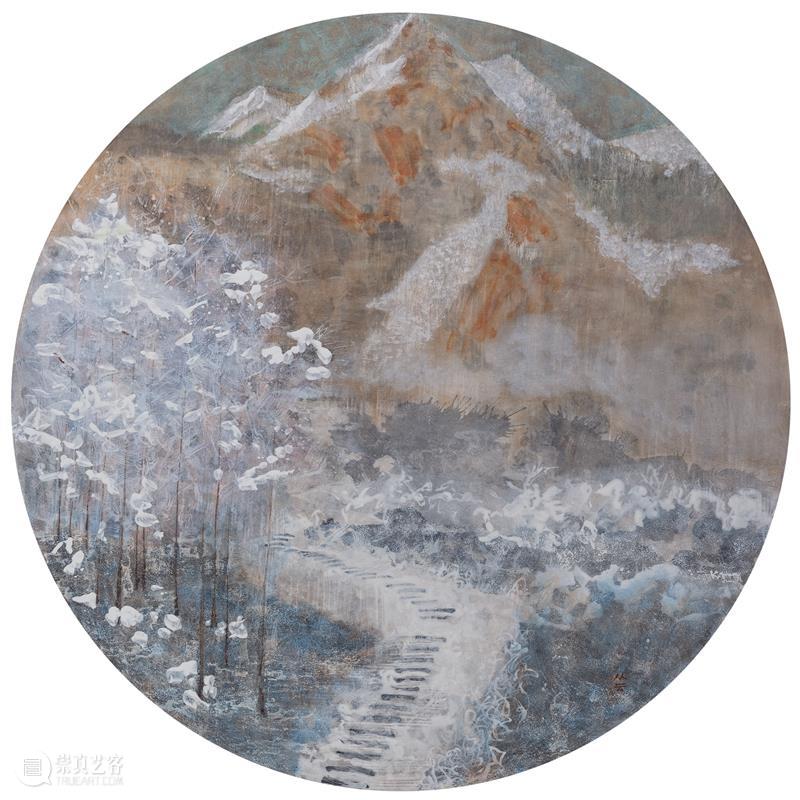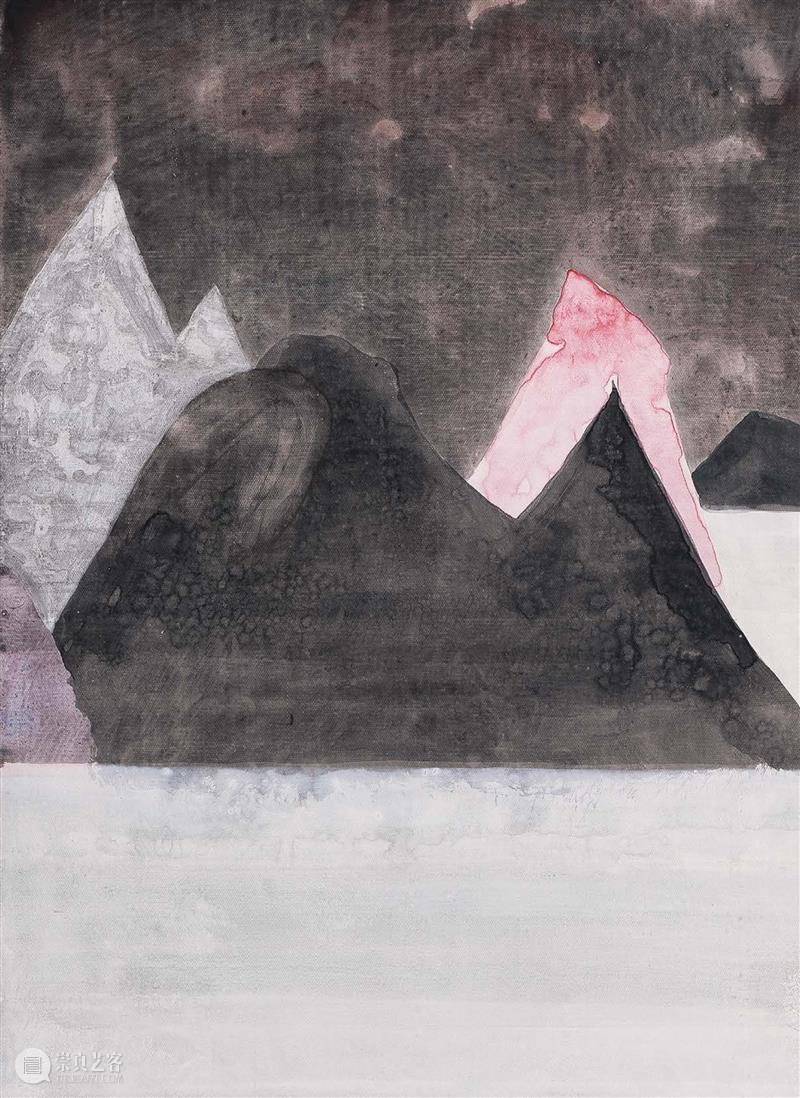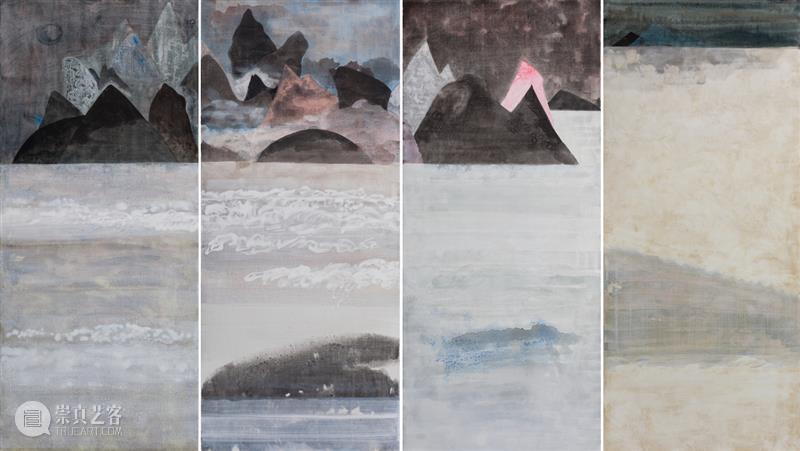

面对张从云的画时,必有身临其境之氛围。画面虽笼罩着静谧的东方禅意,但是鲜艳灵动 —— 这些传统水墨画中常见的自然景观:山峦,磐石,云雾,流水,树木,在油彩、丙烯、坦培拉等综合材料的融合与渲染下,显得悠然且生机勃勃,再加之以多形态的画布(团扇式的圆形、立轴式的长卷、屏风式的分屏)承托,张从云的绘画饱含新意,如同向观者讲述古老而神秘的故事,却由一个快活无忧的少年娓娓诉说。
Zhang Congyun's paintings are always immersive. Although the works are characterized by the calm atmosphere typical of oriental Zen, they are also vibrant and bright in terms of representation of the elements of Chinese traditional landscape ink paintings such as mountains, rocks, clouds, water, and trees. This visual elements are represented through a wide range of materials spanning oil paint, acrylic, and tempera. Supported by canvases of different shapes (round fan-like circles, vertical scrolls, and screen-like canvases), Zhang Congyun’s paintings are vivid and vibrant, full of new ideas, as if they were whispering to the viewers mysterious and intriguing tales from the past. The narrator is the artist, who is a happy and cheerful character.


Both the depicted scenes and their representation convey a sense of tranquillity, while not being dull. This achievement is the result of the artist's experience and of his temperament. From the point of view of his friends, Zhang Congyun is gentle and quiet, with a cheerful and elegant temperament. His passion for artistic creation and his indifference towards many aspects of life, makes his art not limited to the representation of suffering and pain, but characterized by a tranquil and graceful expression of inner beauty. At the same time, Zhang Congyun constantly carries out experiment in terms of visual language and techniques to re-elaborate traditional visual elements through the lens of contemporary artistic language. For example, in Mirage Mountain(2015), the mountains are represented as if they were surrounded by smoke; the use of tempera and other materials makes the chromatic composition of the work extremely contemporary, giving the impression the mountains keep on breathing and growing.

In this hyper-modern era, Zhang’s canvases are still characterized by ever growing trees and mountains, often depicted within a night setting. We interviewed Zhang Congyun to delve into his artistic practice, his curiosity about researching with mixed media and his preference for nocturnal setting.
P = PVG ART 芳草地画廊 Z = ZHANG CONGYUN 张从云
When did you start developing your personal style and what was your source of inspiration?
More than ten years ago, while I was researching the expressive and technical possibilities of tempera, I realized that, through the combination of oil and water, very interesting visual effects could have been achieved. Before that, my painting experience was based on experimenting with figurative and abstract languages and on formalistic research. However, I have been always interested in ink painting, as my grandfather was a master of calligraphy: I think that this legacy exerted a subtle influence in my artistic activity. Therefore, by adopting western painting techniques to represent eastern creative concepts, I managed to use figurative and concrete elements to represent the notion of abstraction in terms of representation of space and scenes. This approach still characterizes my artistic practice, even though now the images undergone some changes.

P:您的作品常在同一平面中呈现复杂多样的肌理组合,请和我们谈谈您的创作手法。
Your works often present complex and multifaceted combinations in terms of texture of the canvas. Could you please tell us more about your technique.
Z:不管如何思考,最终还是要落实到画面的视觉语言和呈现方法上。我的创作在选题、选材、表现方式上相对自由和开放 ,表现手法也是自然的。不过“自然”并非自然形成,而是通过不断尝试和自我认知逐渐发展出来的 —— 通过油性媒介、水性材料、树脂、茶色甚至一切可以被利用的媒材,将这些视觉表征因素运用到作品创作中。
Regardless of the thinking process behind a work, in the end it is the idea that needs to be represented on the canvas through a specific visual language and representative technique. My creative approach is rather free and open in terms of selection of subject matter, materials and expressive technique. However, the natural element that characterizes my works has been achieved through continuous experimentation and self-awareness. Oil, watercolor, resin, brown colors and other media contribute to shape the visual language of my artistic creations.



P:您如何积累自己的原始素材?对您来说,它们更偏向潜意识,还是对现世的认知?
How do you collect your visual repertoire? Is the selection of images for your works more associated with a subconscious dimension or with a cognitive one?
Z:我将日常生活中看的、观察、想的、读的、聊的、网络与实体空间接触到的方方面面贯穿在大脑中。融合大量信息、视觉资源、图像与符号、以及它们带给我的感受和记忆,使我创作时一般不再需要以具体的图像为原始依据。可以说我的素材更偏向潜意识 ,把资源加以筛选再重新“编码”,输出新的视觉结构。
I collect images coming from every aspect of my daily life: they are usually images that I can see, observe, think, read, or images emerging from conversations, internet researches or the surrounding physical space. The combination of a large amount of information, visual resources, images and symbols with feelings and memories these images generate, enables me to break away from the necessity of pursuing a mimetic representation of the original image. So, it can be said that my visual repertoire stems from my subconscious, which I filter and re- elaborate to create a new visual effect.

P:描绘夜间的自然景观对您来说为何重要?
Why depicting natural settings at night is important to you?
Z:我想在时间和心理维度对传统图像进行再叙述。夜间可以是更加喧嚣的,也可以更沉静,因此黑夜中的景观往往表现出更丰富的层次,静谧中的墨色带来比白昼时更微妙复杂的视觉和心灵体验。
I want to reconfigure images of traditional Chinese painting, taking into account the notions of time and psychology. Scenes at night can be noisy or quiet: the dark landscape suggests different semantic and interpretative layers. The black ink in the depiction of nocturnal scenes brings more subtle and complex visual experiences than in daytime representations.


P:请谈谈您绘画中的空间意识。
Could you talk about the notion of space in your paintings.
Z:空间是一个并不主要但重要的问题。与其实现对物理空间的完全再现,我更希望创造出偏向传统审美的“意向空间”。所以画面中无论留白还是叠加,都是对平面的再传达,是让画面的主体,即山、云、树、石等具向形态有所依托。它们是二维空间平面看似合理的需要,尽管有时其实是矛盾的空间。
While being important, space is not the main focus of my works. Instead of realizing a mimetic reproduction of the physical space, I am more interested in representing the notion of space associated with Chinese traditional aesthetics. Therefore, whether it is left blank or it is filled with objects, the spatial structure of the painting provides the main body of the picture, namely the mountain, the cloud, trees, stones and other specific forms with a visual support. These elements have their own raison d'être in a two-dimensional space, although sometimes they establish a contradictory spatial relationship.


P:用具象方式呈现山峰、树木与云雾,是内在自我的个人探索,还是“无我”的表达?
The mountain, trees, and clouds are presented through a figurative language. Does this represent a personal exploration of the intimate self, or is it more an expression of selflessness?
Z:很难划分,“天下万物生于有,有生于无。” 艺术创作本来就类似“无中生有”,无论看似多么无我,都有作者的内在诉求。我作品中具象呈现的山峰、云雾与树木,流水,是比较传统的视觉资源,但也都并非只是在表现其本身,而是根据需要纳入到的绘画结构予以其当代性的转化。因此还是个人表达需要,“选择”本身就是一种态度。
It is difficult to separate one from the other. “The elements come from being, while being comes from nothingness.” Art creation is similar to the concept of “being within nothingness”. No matter how selfless they seem, artworks are inevitably imbued with the author's thoughts. Mountains, clouds, trees, and flowing water are represented in my works through a traditional iconography. However, they are not depicted just to represent concretely themselves; on the contrary, they are incorporated into the painting structure to serve the purpose of suggesting a connection with the contemporaneity. The representation of these visual elements is driven by the need for personal expression: I believe that even the personal choice of selecting the visual repertoire suggests a personal attitude.


△ 蜃山 Mirage Mountain
布面丙烯 Acrylic on canvas
200 × 200 cm 2015
P:疫情是否使您的创作或生活发生变化?您如何看待与参与当代都市生活?
How does pandemic affect your life and artistic creation? And in what way do you participate in contemporary urban life?
Z:心态上没有太大改变,性格使然不容易恐慌紧张,做好该做的事情,正常生活。参与当代都市生活?身在其中。
There aren’t many changes in my thinking system. In general, I don’t panic easily. So, I just do what I should do and try to live a normal life. You asked how do I participate in contemporary urban life? I just try to be part of it.

本文图片来自艺术家和芳草地画廊
photo credit to the artist and Parkview Green Art

张从云1976年出生于北京,毕业并任教于中央美术学院城市设计学院。主要展览包括库里蒂巴国际当代艺术双年展,奥斯卡尼迈耶博物馆,巴西,2019,艺术北京,全国农业展览馆,北京,2018,智造-中国当代艺术展,智利,2017,语上-张从云个展,桥艺术空间,北京,2017,色彩共生-中国当代艺术展,当代艺术博物馆,巴拿马,2016,等。
Zhang Congyun was born in Beijing in 1976. He graduated from the Central Academy of Fine Arts and has been teaching there. His main exhibitions include The 14th Curitiba International Biennale of Contemporary Art, Oscar Nimeyer Museum, Curitiba, Brazil, 2019, Art Beijing, Argricultural Exhibition Hall, Beijing, 2018, Infinite Ingenuity-Chinese Contemporary Art Exhibition, Chile, 2017, Congyun's Solo Exhibition, Bridge Art Space, Beijing, 2017, Color Symbiosis-Chinese Artist Exchange Exhibition, Museum of Contemporary Art, Panama, 2016, etc.
艺术家作品于芳草地画廊发售中,
更多咨询请与我们联系。
Artworks on sale at Parkview Green Art, please contact us for more information.

Opening Hours: Every day 10:00-22:00
【媒体垂询 I Media Contact】
www.parkviewgreenart.com



已展示全部
更多功能等你开启...





 分享
分享